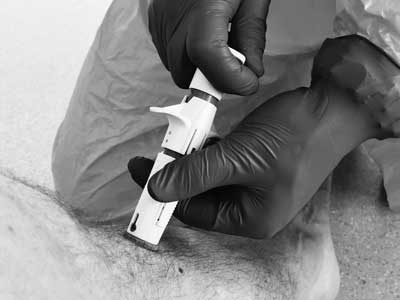Anna Drozd1, Karol Bielski1, *Jacek Smereka1, 2, Klaudiusz Nadolny3, 4, Maciej Cyran1, 5, Maciej Fudalej6, Lukasz Szarpak1, 7
Which intravascular access technique should we use for covid-19 patient resuscitation: a preliminary investigation
1Polish Society of Disaster Medicine, Warsaw, Poland
2Department of Emergency Medical Service, Wroclaw Medical University, Poland
3Department of Emergency Medical Service, Strategic Planning University of Dabrowa Gornicza, Poland
4Faculty of Medicine, Katowice School of Technology, Poland
5Maria Sklodowska-Curie Medical Academy in Warsaw, Poland
6Department of Forensic Medicine, Medical University of Warsaw, Poland
7Bialystok Oncology Center, Poland

To the Editor
Obtaining vascular access is a key procedure in hemodynamically unstable patient conditions (1). This is particularly important for patients with cardiac arrest, where the American Heart Association (AHA) as well as the European Resuscitation Council (ERC) recommendations for non-shockable rhythms recommend that vascular access and adrenaline supply be provided as soon as possible (2, 3). Under CPR conditions, the vascular bed is collapsed, therefore numerous attempts at intravenous access may prolong the time to administer drugs and CPR fluids, as well as cause the rescuer to focus too much on one procedure, while under out-of-hospital CPR settings the number of members of the emergency team is limited and the need for chest compressions, as well as airway management and ventilation support, are important (4). Ready-to-use kits for performing intraosseous accesses, including NIO-Adult, which is an example of an automatic, spring-loaded, single-use intraosseous access device (fig. 1), may be helpful in this respect.

Fig 1. A detailed randomization procedure is shown
Fig. 1. NIO-Adult intraosseous access device
The aim of the study was to compare the success rate, procedure time, and user satisfaction of NIO-Adult compared to intravenous access performed by paramedics wearing full personal protective equipment during simulated suspected/confirmed COVID-19 adult patient resuscitation.
Powyżej zamieściliśmy fragment artykułu, do którego możesz uzyskać pełny dostęp.
Mam kod dostępu
- Aby uzyskać płatny dostęp do pełnej treści powyższego artykułu albo wszystkich artykułów (w zależności od wybranej opcji), należy wprowadzić kod.
- Wprowadzając kod, akceptują Państwo treść Regulaminu oraz potwierdzają zapoznanie się z nim.
- Aby kupić kod proszę skorzystać z jednej z poniższych opcji.
Opcja #1
29 zł
Wybieram
- dostęp do tego artykułu
- dostęp na 7 dni
uzyskany kod musi być wprowadzony na stronie artykułu, do którego został wykupiony
Opcja #2
69 zł
Wybieram
- dostęp do tego i pozostałych ponad 7000 artykułów
- dostęp na 30 dni
- najpopularniejsza opcja
Opcja #3
129 zł
Wybieram
- dostęp do tego i pozostałych ponad 7000 artykułów
- dostęp na 90 dni
- oszczędzasz 78 zł
Piśmiennictwo
1. Szarpak L, Truszewski Z, Smereka J et al.: A Randomized Cadaver Study Comparing First-Attempt Success Between Tibial and Humeral Intraosseous Insertions Using NIO Device by Paramedics: A Preliminary Investigation. Medicine (Baltimore) 2016; 95(20): e3724.
2. Szarpak L, Czyzewski L, Woloszczuk-Gebicka B et al.: Comparison of NIO and EZ-IO intraosseous access devices in adult patients under resuscitation performed by paramedics: a randomized crossover manikin trial. Am J Emerg Med 2016; 34(6): 1166-1167.
3. Robak O, Pruc M, Malysz M et al.: Pre-filled syringes with adrenaline during cardiopulmonary resuscitation in nonshockable rhythms. Pilot randomised crossover simulation study. Disaster Emerg Med J 2020; 5(2): 79-84.
4. Szarpak L, Truszewski Z, Smereka J et al.: Ability of paramedics to perform intraosseous access. A randomized cadaver study comparing EZ-IO® and NIO® devices. Resuscitation 2016; 104: e5-6.
5. Borron SW, Arias JC, Bauer CR et al.: Intraosseous line placement for antidote injection by first responders and receivers wearing personal protective equipment. Am J Emerg Med 2011; 29(4): 373-381.
6. Smereka J, Szarpak L, Filipiak KJ et al.: Which intravascular access should we use in patients with suspected/confirmed COVID-19? Resuscitation 2020; 151: 8-9.
7. Szarpak L, Truszewski Z, Smereka J et al.: Comparison of two intravascular access techniques when using CBRN-PPE: A randomized crossover manikin trial. Am J Emerg Med 2016; 34(6): 1170-1172.
otrzymano: 2020-04-03
zaakceptowano do druku: 2020-04-24
Adres do korespondencji:
*Jacek Smereka
Department of Emergency Medical Service Wroclaw Medical University
Wybrzeże Ludwika Pasteura 1, 50-367 Wroclaw, Poland
jacek.smereka@umed.wroc.pl
Postępy Nauk Medycznych 2/2020Strona internetowa
czasopisma Postępy Nauk Medycznych
